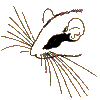

Dormouse Talk Instructions and Archives
How to Subscribe
Compliled and Edited by Werner
Haberl
Number of recipients: > 120
Please share your thoughts and answers with the rest of the group!
Replies to the following messages should be sent as CC-Mail to dormouse@glirarium.org
On 6-7 October I checked my Muscardinus nestboxes once again. The results were excellent: I found 63 dormice at my main study site with 272 nestboxes. The number of dormice caught is even a bit larger than in September.
In Lithuania, this autumn is very favourable for dormice. Very good feeding conditions (a good crop of hazel and oak at the same time, a lot of berries of buckthorn (Frangula alnus) and very favourable weather (it is warm and not rainy).
There were many cases of late breeding in Muscardinus this autumn. I also found two females born this year with offspring. The weight of all adult Muscardinus caught and the weight of some early born juveniles was over 30 g. One juvenile born this year reached the weight of 35 g, other - 34 g. Probably also late born juveniles will be able to accumulate sufficient fat reserves this autumn. Earlier I planned, that it would be the last nestbox-check for this year, but now I am going to do one more check in October.
Best wishes,
Rimvydas
P.S. Where did the other dormousers disappear to?
Dr. Rimvydas Juškaitis
Institute of Ecology, Akademijos 2, LT-2600 Vilnius, Lithuania
Dear Werner,
You raised many interesting questions in "Dormouse Talk" (No 4 & 5), and I expected interesting discussions. However only the question about competition for nestboxes received more comments.
You asked the very interesting question, "do nestboxes attract dormice"? I hoped that Pat Morris would join this discussion, because his paper (Morris et al., 1990) affirms that the presence of nestboxes increases the number of dormice in the area. I agree with this proposition only partially.
There was a question by Rod Baxter about nestboxes for dormice studies. Nobody wrote about special dormice nestboxes. Many dormousers use them, but I do not see any advantage of these nestboxes. Maybe in some cases it is easier to get money for producing them?
It is paradoxical that in Great Britain, where the common dormouse is held as declining species, and whose distribution area decreased twice in the last 100 years (Bright & Morris, 1996), its populations density is estimated about 8-10 adult individuals per hectar (Bright & Morris, 1992). Meanwhile in Lithuania this species is widespread and not declining, though population density is several times lower (on average only 1 adult/ha). What are the reasons of such differences?
It would be very useful if Pat Morris and Paul Bright would join the discussions in "Dormouse Talk". In Edirne, Sven Buechner wanted to discuss about estimating population density.
With best regards,
Rimvydas
Number of Visitors (Date: 5 September 2000): >1380
Number of recipients: >120
Dormouse Talk Instructions: ... how to join, post & leave
Dr. Werner Haberl
Editor of DORMOUSE TALK & SHREW TALK
Chair, Insectivore Specialist Group
Species Survival Commission
IUCN - The World Conservation Union
Hamburgerstr. 11, A-1050 Vienna, Austria
Email: dormouse@glirarium.org
The Dormouse Hollow: www.glirarium.org/dormouse
The Shrew Shrine: members.vienna.at/shrew
IUCN / ITSES: members.vienna.at/shrew/itses.html
Back to Dormouse Talk Archives / Index